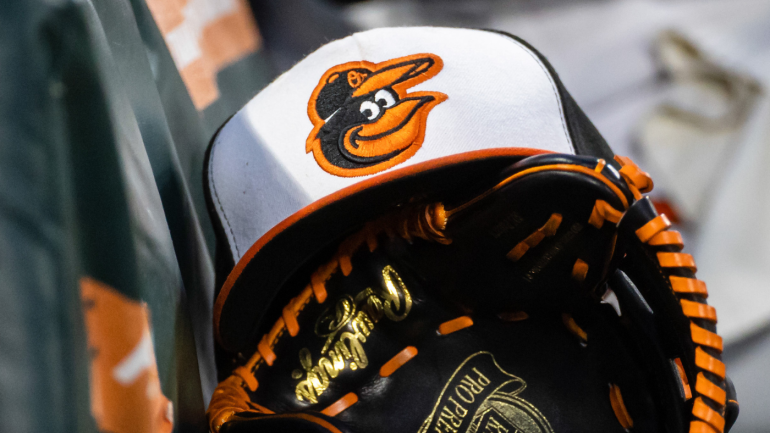
It's fair to write that the Baltimore Orioles were the team to watch entering Major League Baseball's 2022 amateur draft. The Orioles possessed five of the draft's top 100 selections, including picks Nos. 1, 33, 42, and 67 on the first night. Resultingly, the Orioles had the majors' largest bonus pool, with nearly $17 million to dole out.
Mike Elias and company, then, had a golden opportunity to infuse their farm system with more talent. With more than a handful of rounds out of the way, it's time to get hasty and ask: just how did the Orioles fare in accomplishing that goal? In our estimation -- and bear in mind, day-of-draft analysis is as reliable as a cure for hiccups -- they should exit their war room on Tuesday with pep in their steps.
Let's recap the Orioles' top-100 selections in a convenient bullet-point manner (you can recap any team's selections using our handy-dandy draft tracker):
No. 1, Jackson Holliday, SS, Stillwater HS (OK): Holliday was ranked third on CBS Sports' pre-draft top 30, but he was one of several defensible No. 1 selections in this year's class. He put in the work this spring, showing up in better shape and with a newfound approach at the plate that allowed him to make hard contact to all fields. The upside here is a lefty-swinging shortstop with a plus bat. That's a valuable profile, and one that could have him make multiple All-Star Games during his career, à la his father Matt.
No. 33, Dylan Beavers, OF, Cal: Beavers was another member of CBS Sports' top 30, checking in at No. 29. He bookended a poor showing in last summer's Cape Cod League with monster years at Cal, including this past spring, when he improved upon his strikeout and walk rates. Beavers has big power and he could fake it in center for the time being, but his swing-and-miss issues and his tendency to run jagged routes will test his ceiling. If the Orioles can work with him on those aspects, they could unlock a higher ceiling. He was expected to come off the board around the end of the first round anyway, so the Orioles can't feel too bad if he ends up being just a power-over-hit corner outfielder.
No. 42, Max Wagner, 3B, Clemson: One veteran talent evaluator told CBS Sports in the week leading up to the draft that Wagner was benefitting from late helium after hitting .370 with 27 home runs this season for the Tigers. Sure enough, he landed just outside of the first round. Wagner's ball-tracking data indicates he has at least plus raw power, and he did a better job of leveraging it this season. He's also displayed a good feel for the strike zone, allowing him to post a 1.1 strikeout-to-walk ratio. If Wagner's offensive gains prove sustainable, he could shift the perception of him from a reach to a steal.
No. 67, Jud Fabian, OF, Florida: Fabian is no stranger to our draft coverage. He was a highly touted prospect entering the 2021 season who has since struggled with strikeouts and swing-and-miss issues. Fabian improved upon his K rate this season, but hit just .239, an unthinkably low mark for a good collegiate prospect. As with Wagner and Beavers, Fabian has real power, meaning the Orioles tripled-down on their developmental staff's ability to help them all make more contact.
No. 81, Nolan McLean, P, Oklahoma State: The Orioles capped off their top-100 selections with McLean, a two-way player who has big power -- surprise, surprise -- but will likely be used as only a pitcher because of his contact issues. (Sense a theme yet?) McLean struck out 39 of the 111 batters he faced this season in relief while chucking his high-spin fastball into the upper-90s. He needs to firm up the rest of his arsenal and his command.
To sum it up, the Orioles landed a legitimate No. 1 pick; three college hitters with power-over-hit profiles; and an interesting relief arm project. That's a good haul on paper that has a chance to bear more fruit down the road, depending on whether or not Baltimore's instructors can indeed help the collegiate trio's hit tools tick up.
It's worth noting that the Orioles had this draft without needing to resort to their tried-and-true portfolio approach. Baltimore did not take Holliday because he came cheap; rather, the Associated Press reported overnight that he's believed to have an agreement in place on a deal that will pay him a bonus worth more than $8 million. Provided that report is correct, the Orioles still had nearly $9 million to spread around the rest of their class, or more than 15 teams had in their entire bonus pools.
In other words, the Orioles lived up to their billing as the team to watch in this year's draft. Now comes the hard part: turning those players into big-league contributors.


















